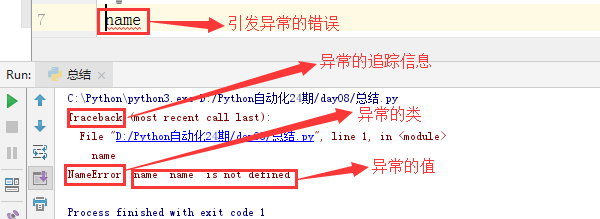一、什么是异常
异常就是程序运行时发生错误的信号(在程序出现错误时,则会产生一个异常,若程序没有处理它,则会抛出该异常,程序的运行也随之终止),在python中,错误触发的异常如下:

1、错误的类型
①语法错误:这种错误,根本过不了python解释器的语法检测,必须在程序执行前就改正

#语法错误示范一 if #语法错误示范二 def test: pass #语法错误示范三 class func pass #语法错误示范四 print(hello word
②逻辑错误

#TypeError:int类型不可迭代 for i in 3: pass #ValueError num=input(">>: ") #输入hello int(num) #NameError aaa #IndexError l=['aa','bb'] l[3] #KeyError dic={'name':'alex'} dic['age'] #AttributeError class Foo:pass Foo.x #ZeroDivisionError:无法完成计算 res1=1/0 res2=1+'str'
2、异常的种类
①常用异常

AttributeError 试图访问一个对象没有的树形,比如foo.x,但是foo没有属性x IOError 输入/输出异常;基本上是无法打开文件 ImportError 无法引入模块或包;基本上是路径问题或名称错误 IndentationError 语法错误(的子类) ;代码没有正确对齐 IndexError 下标索引超出序列边界,比如当x只有三个元素,却试图访问x[5] KeyError 试图访问字典里不存在的键 KeyboardInterrupt Ctrl+C被按下 NameError 使用一个还未被赋予对象的变量 SyntaxError Python代码非法,代码不能编译(个人认为这是语法错误,写错了) TypeError 传入对象类型与要求的不符合 UnboundLocalError 试图访问一个还未被设置的局部变量,基本上是由于另有一个同名的全局变量, 导致你以为正在访问它 ValueError 传入一个调用者不期望的值,即使值的类型是正确的
②更多异常

ArithmeticError
AssertionError
AttributeError
BaseException
BufferError
BytesWarning
DeprecationWarning
EnvironmentError
EOFError
Exception
FloatingPointError
FutureWarning
GeneratorExit
ImportError
ImportWarning
IndentationError
IndexError
IOError
KeyboardInterrupt
KeyError
LookupError
MemoryError
NameError
NotImplementedError
OSError
OverflowError
PendingDeprecationWarning
ReferenceError
RuntimeError
RuntimeWarning
StandardError
StopIteration
SyntaxError
SyntaxWarning
SystemError
SystemExit
TabError
TypeError
UnboundLocalError
UnicodeDecodeError
UnicodeEncodeError
UnicodeError
UnicodeTranslateError
UnicodeWarning
UserWarning
ValueError
Warning
ZeroDivisionErro
二、异常处理
1、如果错误发生的条件是可预知的,我们需要用if进行处理:在错误发生之前进行预防

num=10 while True: age=input('>>: ').strip() if age.isdigit(): #只有在age为字符串形式的整数时,下列代码才不会出错,该条件是可预知的 age=int(age) if age == num: print('666') break
2、如果错误发生的条件是不可预知的,则需要用到try...except:在错误发生之后进行处理

#基本语法为 try: 被检测的代码块 except 异常类型: try中一旦检测到异常,就执行这个位置的逻辑 #举例 try: f=open('a.txt') g=(line.strip() for line in f) print(next(g)) print(next(g)) print(next(g)) print(next(g)) print(next(g)) except StopIteration: f.close()
3、try...except类型
①单分支:异常类只能用来处理指定的异常情况,如果非指定异常则无法处理

s1 = 'hello' try: int(s1) except IndexError as e: # 未捕获到异常,程序直接报错 print e
②多分支:如果你对错误原因需要进行不同分流或者程序处理

s1 = 'hello' try: int(s1) except IndexError as e: print(e) except KeyError as e: print(e) except ValueError as e: print(e
③万能异常Exception:如果对错误原因不关心,只是想不让其报错,那么程序中你就用万能处理

s1 = 'hello' try: int(s1) except Exception as e: print(e)
④多分支异常与万能异常:对某些错误需要进行分流处理,剩下的错误直接跳过

s1 = 'hello' try: int(s1) except IndexError as e: print(e) except KeyError as e: print(e) except ValueError as e: print(e) except Exception as e: print(e)
⑤其它异常:如果出现异常 就不会走else逻辑,不出现异常,则执行else逻辑

try: print('二狗 向 脸哥转了 200元') name print('脸哥确认收到了 200元') except NameError: print('name is not defined') else: print('转账成功') print(666)
⑥try except else finally:无论报不报错都执行,如果报错,finally是在报错之前执行的!!!

try: print('二狗 向 脸哥转了 200元') name print('脸哥确认收到了 200元') except KeyError: print('name is not defined') # # else: # print('转账成功') # finally: print(666)
⑦主动抛出异常

try: raise TypeError('类型错误') except Exception as e: print(e)
⑧自定义异常

class PhoneConnectionError(BaseException): pass try: raise PhoneConnectionError('类型错误') except PhoneConnectionError: print('手机连接出现问题')
⑨断言:assert 条件

assert 1 == 1 assert 1 == 2
三、什么时候用异常处理
1、首先try...except是附加给你的程序的一种异常处理的逻辑,与你的主要的工作是没有关系的,这种东西加的多了,会导致你的代码可读性变差
2、只有在错误发生的条件无法预知的情况下,才应该加上try...except
3、有的同学会这么想,学完了异常处理后,好强大,我要为我的每一段程序都加上try...except,坚决不允许……
